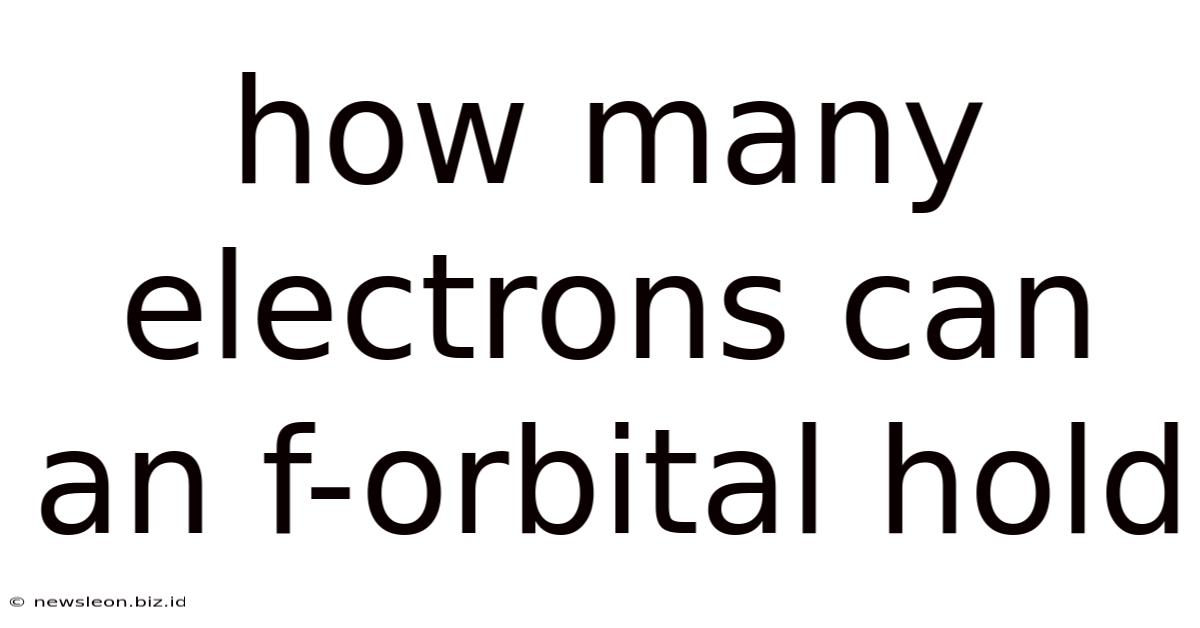How Many Electrons Can An F-orbital Hold
News Leon
May 02, 2025 · 5 min read

Table of Contents
How Many Electrons Can an F-Orbital Hold? A Deep Dive into Atomic Orbitals
Understanding electron configuration is fundamental to grasping the behavior of atoms and molecules. This article delves into the intricacies of atomic orbitals, focusing specifically on the f-orbital and its electron capacity. We will explore the quantum numbers that define these orbitals, the shapes of these complex orbitals, and finally answer the central question: how many electrons can an f-orbital hold?
Understanding Atomic Orbitals and Quantum Numbers
Before we tackle the f-orbital, let's establish a foundation in atomic orbital theory. Electrons within an atom don't occupy random spaces; instead, they reside in specific regions called atomic orbitals. These orbitals are defined by a set of four quantum numbers:
1. Principal Quantum Number (n)
This number dictates the energy level of an electron and its average distance from the nucleus. It's always a positive integer (n = 1, 2, 3, ...). Higher values of 'n' correspond to higher energy levels and greater distances from the nucleus.
2. Azimuthal Quantum Number (l)
This quantum number describes the shape of the orbital and its angular momentum. It can take integer values from 0 to (n-1). Different values of 'l' correspond to different subshells:
- l = 0: s-orbital (spherical shape)
- l = 1: p-orbital (dumbbell shape)
- l = 2: d-orbital (complex, multi-lobed shapes)
- l = 3: f-orbital (even more complex, multi-lobed shapes)
3. Magnetic Quantum Number (ml)
This number specifies the orientation of the orbital in space. It can take integer values from -l to +l, including 0. For example:
- For an s-orbital (l=0), ml = 0 (only one orientation).
- For a p-orbital (l=1), ml = -1, 0, +1 (three orientations along the x, y, and z axes).
- For a d-orbital (l=2), ml = -2, -1, 0, +1, +2 (five orientations).
4. Spin Quantum Number (ms)
This quantum number describes the intrinsic angular momentum (spin) of an electron. It can only have two values: +1/2 (spin up) or -1/2 (spin down). This is crucial for understanding the Pauli Exclusion Principle.
The Pauli Exclusion Principle and Electron Capacity
The Pauli Exclusion Principle is a cornerstone of quantum mechanics. It states that no two electrons in an atom can have the same set of four quantum numbers. This principle directly limits the number of electrons that can occupy a given orbital.
Since each electron can have either spin up (+1/2) or spin down (-1/2), each orbital can hold a maximum of two electrons with opposite spins.
The F-Orbital: Shape and Complexity
The f-orbital, characterized by l = 3, is the most complex type of atomic orbital. Its shape is difficult to visualize accurately, but it can be described as having seven distinct orientations, each corresponding to a different value of ml (-3, -2, -1, 0, +1, +2, +3). These shapes are far more intricate than the simpler s, p, and d orbitals. They possess multiple lobes and nodal planes (regions where the probability of finding an electron is zero). Visual representations often show these orbitals as having eight lobes, but this is a simplification. The true shapes are more complex and often described mathematically.
How Many Electrons Can an F-Orbital Hold?
Now, we can finally answer the central question. Because there are seven f-orbitals (one for each value of ml) and each orbital can hold a maximum of two electrons (due to the Pauli Exclusion Principle), an f-subshell can hold a total of 14 electrons.
f-Orbitals and the Periodic Table
The f-orbitals are first populated in the lanthanide and actinide series of elements, also known as the inner transition metals. These elements are located at the bottom of the periodic table and their chemical properties are heavily influenced by the filling of the f-orbitals. The subtle energy differences between the f-orbitals and other orbitals are responsible for the unique and often complex chemical behavior of these elements.
Applications and Importance of Understanding f-Orbitals
Understanding the electronic structure of f-orbitals is vital in several scientific fields. These include:
-
Materials Science: The properties of many advanced materials, including superconductors and magnets, are directly related to the electronic configuration of f-orbital electrons. Designing new materials with specific properties often involves manipulating the electron arrangement in these orbitals.
-
Nuclear Chemistry: The behavior of actinide elements, which have partially filled f-orbitals, is crucial in nuclear fission and nuclear energy production. Understanding their electron configuration is essential for predicting their reactivity and for the development of safer and more efficient nuclear technologies.
-
Catalysis: Lanthanide and actinide compounds are used as catalysts in various chemical reactions. The f-orbitals play a critical role in their catalytic activity.
-
Medical Applications: Some lanthanide compounds, often involving f-orbital electrons, find applications in medical imaging (e.g., MRI contrast agents) and cancer therapy.
Conclusion: A Deeper Understanding of Electronic Structure
The f-orbital, with its capacity to hold 14 electrons, is a testament to the complexity and richness of atomic electron configuration. This understanding extends beyond theoretical chemistry, impacting various fields including materials science, nuclear chemistry, catalysis, and medicine. By grasping the fundamentals of quantum numbers and the Pauli Exclusion Principle, we can accurately predict and explain the behavior of atoms and molecules, leading to advancements in diverse scientific and technological applications. This foundational knowledge is crucial for anyone pursuing a deeper understanding of the quantum world. Further exploration into the more nuanced aspects of electronic structure, such as electron-electron repulsion and relativistic effects, provides even greater insight into the complexities of these orbitals and their impact on the properties of the elements.
Latest Posts
Related Post
Thank you for visiting our website which covers about How Many Electrons Can An F-orbital Hold . We hope the information provided has been useful to you. Feel free to contact us if you have any questions or need further assistance. See you next time and don't miss to bookmark.